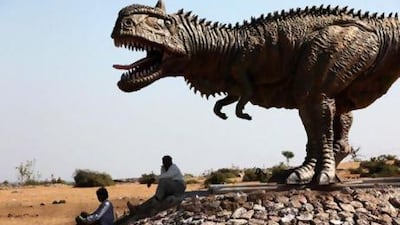BALASINOR, INDIA // The prized possession of Aliya Sultana Babi, a member of the family that used to rule this former princely state in Gujarat, is a fossilised dinosaur egg. The egg, the size of a woman's hand, sits in a red velvet jewellery box, ensconced in a bed of white silk. Her brother found it more than a decade ago in a nearby village, where a woman was using it to grind spices.
Ms Babi says the homemaker was not alone in her ignorance of the fossil.
"I have heard that some of tribes who live in the interiors used to worship the eggs," she says.
The fossils, first discovered near the tiny village of Raioli by the Geological Survey of India in the early 1980s and now in museums across India, led to one of the world's largest finds. The site stretches from Gujarat for about 800km to Jabalpur in the neighbouring state of Madhya Pradesh.
Sardar Singh Kalu Singh Chauhan, 75, who lives in Raioli, remembers when the paleontologists first arrived. "They used to come for the digs from Jaipur and we were not sure what they were looking for," he says. "They kept putting these large pieces of rocks in their cars and driving away. We used to have a good laugh about that."
When the villagers finally learnt these rocks were the fossilised remains of a gigantic extinct species, they were even more astounded. "These rocks were animals? That was our first reaction," says Magan Varam, 60.
One of those fossils, found to be 67 million years old, was a new species of dinosaur. Jeffrey Wilson, a paleontologist from the University of Michigan in the United States, was part of the team that discovered the Rajasaurus narmadensis, a Tyrannosaurus rex-like carnivore. The Rajasaurus, whose name means "princely lizard from the Narmada Valley," had an unusual hornlike growth above its nasal cavity.
Today, the rural landscape is dominated by a six-metre tall, life-size replica of a roaring Rajasaurus, made of metal and cement and mud with an exterior of brass paint. The former Balasinor royal family have become the unofficial protectors of the fossil fields and are eager to turn it into a tourist destination.
A museum is due to open next month, set up by the Gujarat government, and the villagers are excited about the prospect of jobs tourists will bring, as well as the bragging rights of living next to what they call, "mota prani", or "giant forms of life" in Gujarati.
Dr Wilson believes that dinosaurs in India followed a unique evolutionary trajectory, spending hundreds of millions of year isolated after the landmass that is now India separated from Australia and collided with Central Asia, creating the Himalayas. "The dinosaurs show us the last chapter of India's pre-Himalayan history," he says. Dr Wilson has been to Raioli five times in the past decade and describes a certain "magic" at the site.
"Raioli has fascinating fossils we don't see anywhere else. Some of the bones are jutting out of the rocks," he says.
Among paleontologists, the site is best known for a fossil of a snake curled around a clutch of dinosaur eggs.
Discovered in 2000 during one of Dr Wilson's visits to Balasinor, it appears to show a 3.5-metre-long prehistoric snake, called a Sanajeh, in the process of devouring one of the eggs.
The find led to two important discoveries for paleontologists: that non-dinosaurs preyed upon dinosaurs and that dinosaurs in India did not guard their eggs.
About 17 species of dinosaur have been identified in the so-called "Lameta Formation", the section of sedimentary rock in which the area's fossils are found. Of those, two are unique to the area: the Rajasaurus and the Jainosaurus, a Brontosaurus-like herbivore.
Uday Singh, 85, a former head of the area's villages, says that word had spread about the dinosaurs, including among his relatives.
"When they visit, they want to go visit the hills. We show them around, and we have learnt to identify a few," says Mr Singh, who is now nearly blind. "It makes me proud to know the world knows about us now.
"And all for this big animal that is embedded in stone."
sbhattacharya@thenational.ae

India's Jurassic Park hopes 'princely lizards' will attract tourists
The village of Raioli, home to one of the world's largest dinosaur fossil finds, already boasts a six-metre T-rex like Rajasaurus. Suryatapa Bhattacharya reports from Balasinor
Most popular today
